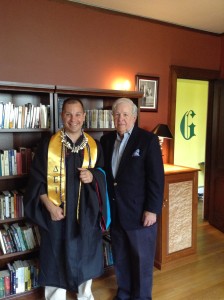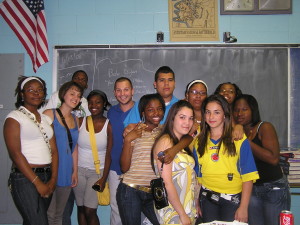AOL (they still exist…I have an email account to prove it) congratulated AA for turning 80 today. In fact, the day that is celebrated as Founder’s Day (June 10) each year by grateful alcoholics is not actually the day AA was created. Bill Wilson (a New York stockbroker) and Dr. Bob Smith (an Akron doctor) met on May 12, 1935 and they discussed their drinking problems with each other. Both left that meeting feeling connected to someone else and hopeful that they could remain abstinent from booze. I view that as the first AA meeting and that date as the founding of Alcoholics Anonymous.
Most people, including Alcohol Anonymous World Services, go with June 10, 1935, which is the last day that Dr. Bob drank. From their website:
Dr. Bob lapses into drinking again but quickly recovers. The day widely known as the date of Dr. Bob’s last drink, June 10, 1935, is celebrated as the founding date of Alcoholics Anonymous. Dr. Bob and Bill spend hours working out the best approach to alcoholics, a group known to be averse to taking directions. Realizing that thinking of sobriety for a day at a time makes it seem more achievable than facing a lifetime of struggle, they hit on the twenty-four hour concept.
But it turns out that his last drink wasn’t June 10 but rather one week later on June 17. After his initial meeting with Bill Wilson, Dr. Bob was able to put a few weeks of continuous sobriety together. He felt so good that he decided to attend the AMA (American Medical Association) Conference in Atlantic City that June. His wife was concerned, but he assured her he would be fine (early recovery people are so similar). This site provides the rest of the story:
That is, until he boarded the train to Atlantic City. Once on the train Dr. Bob began to drink in earnest. He drank all the way to Atlantic City, purchased more bottles prior to checking in to the hotel. That was on a Sunday evening. Dr. Bob stayed sober on Monday until after dinner. He then resumed his drinking. Upon awakening Tuesday morning his drinking continued until noon. He then realized that he was about to disgrace himself by showing up at the convention drunk. He decided to check out of the hotel and return home. He purchased more alcohol on the way to the train depot. He waited for the train for a long time and continued to drink. That was all he remembered until waking up in the home of his office nurse and her husband back in Ohio.
Dr. Bob’s blackout lasted over 24 hours. There was a five-day period from when Dr. Bob left for the convention to when the nurse called Anne and Bill. They took Dr. Bob home and put him to bed. The detoxification process began once again. That process usually lasted three days according to Bill. They tapered Dr. Bob off of alcohol and fed him a diet of sauerkraut, tomato juice and Karo Syrup.
Bill had remembered that in three days, Dr. Bob was scheduled to perform surgery. On the day of the surgery, Dr. Bob had recovered sufficiently to go to work. In order to insure the steadiness of Dr. Bob’s hands during the operation Bill gave him a bottle of beer. That was to be Dr. Bob’s last drink and the “official” Founding date of Alcoholics Anonymous. The operation was a success and Dr. Bob did not return home right after it. Both Bill and Anne were concerned to say the least. They later found out, after Dr. Bob had returned, that he was out making amends. Not drunk as they may have surmised, but happy and sober. That date according to the AA literature was June 10, 1935.
The Archives of the American Medical Association reportedly show that their convention in Atlantic City, in the year 1935 did not start until June 10th. How could Dr. Bob have gone to the convention, by train – check into a hotel – attend the convention on Monday – check out on Tuesday – be in a blackout for 24 hours – go through a three -day detoxification – perform surgery on the day of his last drink – June 10, 1935? Five days had passed since Dr. Bob left for the convention and returned to Akron. There was the three-day detoxification process and then there was the day of the surgery. Approximately nine days had passed from when he left and the date of his last drink. If the records of the American Medical Association are in error as to the date of their convention it is possible that June 10, 1935 was the date of Dr. Bob’s last drink. If the records are in error, the 1935 convention would have been the only one in the history of the American Medical Association that was listed with the wrong date.
I quit the debating society over a decade ago, but I am a history buff and I think it is important that facts be correct. From my viewpoint, AA started on May 12, 1935. If you and yours think that AA started on Dr. Bob’s last drink, then it is June 17, 1935. Regardless of your belief, it is not June 10, 1935.












